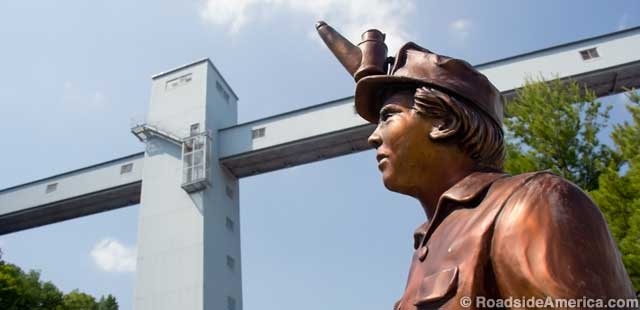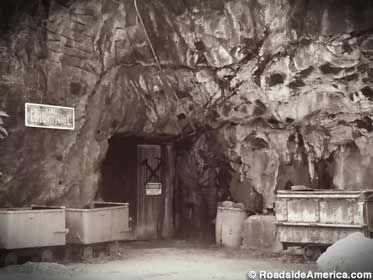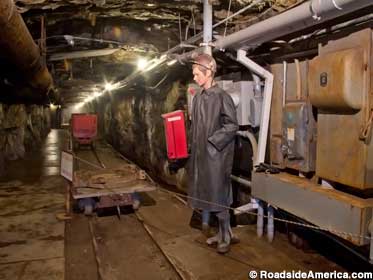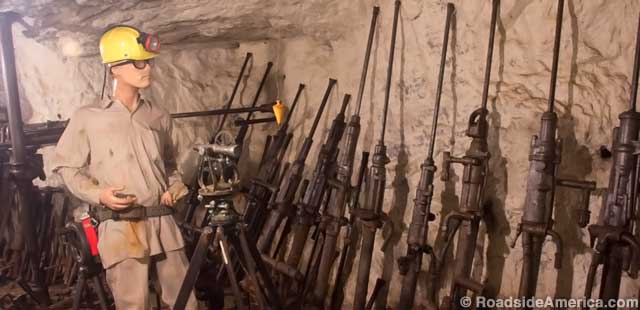
Bronze miner and dramatic remnants of the old zinc mining days.
Mine Tour, Largest Display of Fluorescent Rocks
Ogdensburg, New Jersey
This is what an underground mine attraction should look like. Craggy, scarred cliffs, towering ore processing buildings and catwalks, rusting mine rail cars and piles of mining gear... The Sterling Hill Mining Museum has preserved it all, and conducts a unique tour into the depths of a retired zinc mine.

The Edison Tunnel entrance.
Sterling Hill, in the state's semi-mountainous northwest corner, was New Jersey's last underground mining operation, closing in 1986. Fortunately the Sterling Hill facility was acquired by two dedicated mine fans, brothers Dick and Bob Hauck. They spruced it up and reopened in 1990 as the Sterling Hill Mining Museum. In 1999 the Thomas S. Warren Museum of Fluorescence was added to the attraction, with its hundreds of minerals that glow under back light.
Dick Hauck (now retired) showed us around on a brisk walking tour (We were there to scout a video location for another project, but that didn't turn off our tourist attraction curiosity). Although Hauck was never a miner, he was a knowledgeable and funny guide to the operation and its history (We already knew what coprolite is, but his shtick was amusing anyway).

One of the things we enjoyed about Sterling Hill is the layout: the curving passageways, the descents and ascents, with mining dioramas around every corner. Mannequins sit propped against crates labeled "Explosives" or are positioned climbing ladders. It's all walking -- no mine car ride like other mine tours.
Our favorite moment was when Hauck pointed out a coal car full of ore. "That's left over from when Zoolander shot here," he said. He reached in and lifted a large chunk, daintily, between two fingers. The coal is made of painted foam!
The production crew for the 2001 movie spent two weeks prepping the mine and surrounding locations to look like a Pennsylvania coal mine. "They had truck after truck hauling real coal for that pile [outside], before they realized they could just paint rocks black."

The official tour includes a live blasting demo, but perhaps no mention of Zoolander.
Also interesting to us about Sterling Hill is that for a shut-down facility, it seemed a veritable hive of activity. Outside the gift shop when we arrived, Hauck was diplomatically dressing down a contractor(?) about a delayed delivery of something important. Later we saw a worker up on a cliff (outside the normal tour area), hammering at a jumble of rocks (Hauck said it was unsafe and the guy was removing the hazard). Bang bang bang. As we approached a back mine entrance, the huge metal door -- creak -- opened and out stepped another worker, in helmet and coveralls, covered in grime, pulling a green garden hose. Back in the Museum of Fluorescence a tour group was examining rare minerals; suddenly Hauck and the tour guide were commiserating about something they really needed "by Tuesday." It's as if there was a low level crisis brewing at Willy Wonka's Chocolate Factory....

Bob Hauck explains a large mining operation artifact.
The mine is still a source of high quality fluorescent minerals, sold to help fund the non-profit operation. Each tour visitor goes home with a sample of fluorescent zinc ore in the mine's "Rainbow Room" (The region is rich with fluorescent rocks -- the Franklin Mineral Museum and its collection is just up the road).
In Sterling Hill's Zobel Exhibit Hall there's a version of the Periodic Table of the Elements: 112 cubbyholes with a sample of ore from each element. You'll also see mineral artwork, fossils, and items invented by Thomas Edison, who owned a local iron mining operation.
As good as it is, we get the sense that Sterling Hill is a work-in-progress, with more displays and fun to come.
Note: A 9/11 Memorial stands near the parking lot, a rusted, twisted 20 foot steel I-beam. The beam was donated by Metal Management Northeast, Inc., a New Jersey company directly involved with the cleanup of the World Trade Center site.
In 2020-22, like many indoor and underground attractions, Sterling Hill was mostly closed to the public.





